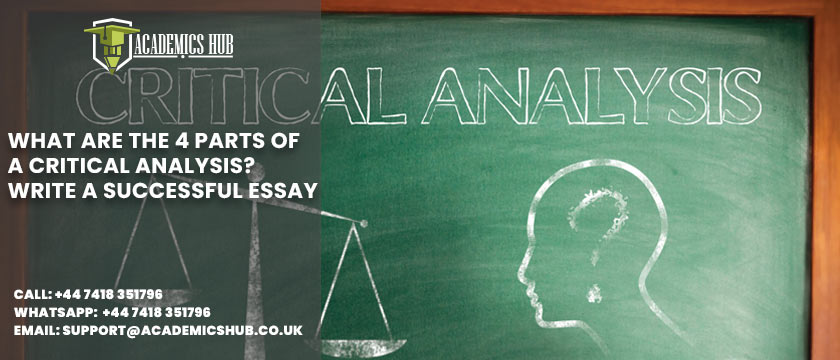Your ability to think critically is demonstrated by writing a critical analysis. This ability is required for some educational courses and employment in the academic area, whether as a critic or in management or decision-making responsibilities. We generally equate the word “critical” with a negative perspective in everyday discourse. However, in a critical analysis essay, the word “critical” merely implies “discerning and analytical.” Rather than passing judgment on the content or quality of a subject, critical analysis parts of essays explore and evaluate its meaning and importance. Critical analysis simply involves your ability to think critically and examine a subject from all possible sides.
Writing a critical analysis essay may appear tedious and challenging, but with the appropriate approach, it can be a rewarding and fruitful experience. We do critical analysis all the time without even realizing it, such as when writing a detailed review of a book or movie. A critical analysis essay focuses on a different key and comprehensive aspects of the work and justifies our judgment regarding the paper’s tone, providing input on a topic in agreement with or in full disagreement with the author’s opinion. This style of essay, in essence, incorporates all forms of critical examination, including reading, thinking, and writing. If you’re looking for high-quality resources for critical essays and academic guidance, it is recommended that you consult the best essay writing service UK.
Defining Critical Analysis & Its Four Parts
The careful investigation and evaluation of another person’s ideas or work are known as critical analysis. Because it communicates your interpretation and analysis of the work by dissecting and examining its components, it is subjective writing. Critical analysis is typically delivered in the form of a written essay or paper, although it can also be done orally. A good critical analysis weighs in on both the positive and negative aspects of an idea or piece of art.
Critical analysis does not always imply detecting flaws in a piece of art. A thoughtful, critical examination, on the other hand, may aid us in comprehending the interaction of the various aspects that contribute to a work’s strength and efficacy. Thus, critical analysis is an important part of academic training; the ability of critical analysis is most typically associated with assessing a work of art or literature, but the same approaches may be used to any discipline’s texts and resources.
FOUR PARTS OF CRITICAL ANALYSIS
1. The Argument’s Identification

Before you can assess the soundness of an argument, you must first dissect it into its constituent parts. Determine the premises and conclusion of the argument. The premises are assertions of known or inferred facts that should not be in conflict with one another. The conclusion is essentially a summary or inference made from the premises. One premise might be that there are five cats in front of you. Another possibility is that all five of the animals you see have tails. These two comments appear to imply that every cat has a tail.
2. Exposition
You can start examining each of the premises for validity once you’ve identified them. Examine the propositions for any ambiguity or vagueness. The premises in the case of the five cats are based on visible reality, so there is no need to doubt their validity. If a premise indicated that the cattails before you were made of cotton, further investigation would be required. The nature of the conclusion would likewise be altered. However, because no odd claims have been made, merely check to see if the implications are reasonable and contain any contradictory information.
3. Reasoning Via Induction And Deduction
Proceed to the conclusion after you have examined the premises. Is it supported by the facts? The conclusion of an argument deduced must be true if the premises are true. You may have already seen a cat without a tail, or you may simply be able to imagine a possible event or genetic aberration that results in a tailless cat, leading you to believe that the conclusion is false. An inductive argument is the one in which the truth value of the conclusion is uncertain, notwithstanding the validity of the previous premises.
4. Final Evaluation

Examine the argument to see if it is sound. Examine the argument for illogical reasoning, false premises, omissions, or assumptions. In the case of the cat argument, it is assumed that there are more cats in the world than there are people. Suppose there weren’t; the characteristics of the five cats who came before all cats would share you. However, the argument is based on an assumption as long as further cats can be produced, even without tails. Examine the structure of the argument to see if it shows a well-thought-out analysis and a well-developed line of reasoning.
How to Compose A Successful Critical Analysis Essay?
The goal of a critical analysis essay is to introduce readers to a topic that they are unaware of, with the main point and purpose clearly stated, as well as presenting your point of view on the issue. Because this is a serious paper, you’ll need an academic and formal approach, as well as well-researched references and other author work to base your article on.
Outline:

The following are the two primary components of a critical analysis essay outline:
- Demonstrating and revealing your knowledge on a subject or topic by supplying appropriate and supporting evidence to authenticate your thesis and point of view;
- Writing a critical analysis essay that follows broad accepted principles and structure and can be read by everyone who understands what critical analysis is.
The Intro & The Body:
The disclosed work will be read in a great and trouble-free manner if the structure of the essay is carefully organized. One of the most important aspects of this type of essay is to convey information that is both simple and important while yet being scholarly and somewhat complicated. Choosing a thesis statement that summarizes what your work will reveal, as well as a brief and informative introductory paragraph and additional body paragraphs, each of which will present new and different information that readers will find useful and understandable due to the structure’s simplicity. An introductory paragraph should catch a reader’s interest and spark their curiosity about the topic at hand. Devoting extra time to this section will ensure not just a great attention-grabber for anybody who reads your paper but also a great approach and consistent writing.
After the introductory paragraph, a successful essay is broken into body paragraphs that present diverse issues. Each paragraph should discuss a variety of topics with a single overarching purpose, which is the essay’s thesis statement. Here you’ll find the supporting evidence, as well as specifics and opposing viewpoints. It is critical to carefully arrange the paper in order to properly provide facts and the overall investigation, so set aside time to estimate the number of paragraphs and the sequence in which the information will be given.
Concluding the Essay
The essay should end with a proper critical analysis conclusion, which restates the thesis and adds the last ideas and observations. Summarizing the concepts and points of view presented in your work, as well as a few minor facts, would be ideal for highlighting the essay’s strengths and flaws, the importance of the selected topic, and why it was determined to be researched further in this final section. To complete the critical analysis essay in a professional and academic manner, conclusions must be written briefly but with a sense of closure. Furthermore, your conclusion should proudly state your opinions, so don’t write it as if you’re not sure what you have analyzed and evaluated.
Remember, while writing a conclusion, one should never introduce a new topic or distinct thought that is not covered in the body of your essay.
Final Thoughts
Critical analysis is more than just paraphrasing or summarizing an author’s words. This approach necessitates a thorough examination of the material offered in work, as well as an assessment of what it means, how it is presented, how it relates to other concepts, and possibly what implications it may have for other viewpoints or pieces of literature. The capacity to analyze an author’s work, whether it’s an essay, a book, or a film, is known as critical analysis. Critical analysis’ ultimate goal is to engage with a book rather than merely reading it and accepting everything it says without question. This will help you comprehend the material better and make more intriguing and insightful observations about the subject.
Furthermore, critical analysis is the core part of critical essays. Don’t be frightened to write a critical analysis essay. There are different types of essay papers, and learning the differences and standards for writing them may seem impossible. Their underlying structure, however, is the same. The main purpose of writing a critical analysis essay is to examine and evaluate the work of other experts. So just read it, find out what the authors were trying to express, decide if you agree or disagree, and then write a critical essay about it all. As a result, you gain critical thinking skills. You learn how to present and defend your points.
